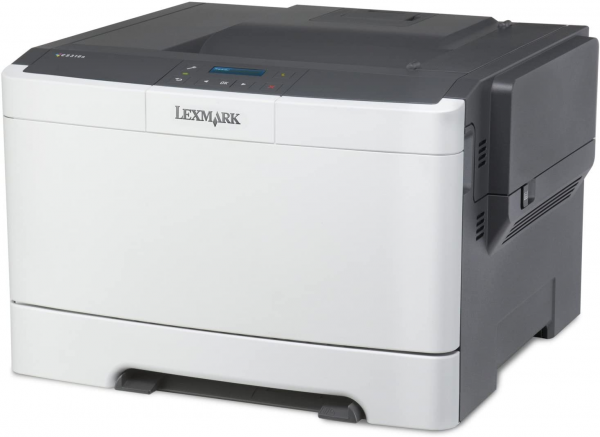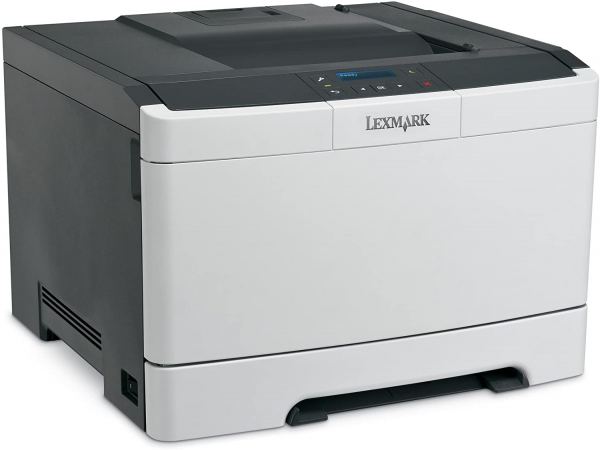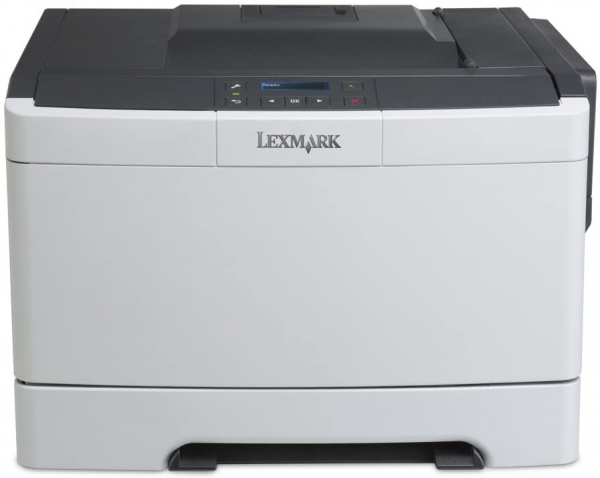Lexmark
Lexmark CS317dn: a benchmark color laser printer
Aprox. 360€ - see price -
See specificationsNearly four years after its test, the Lexmark CS310n is still an excellent choice for a color single-function laser printer, but it is increasingly difficult to find in stores. It is therefore time to look at the most recent CS317dn, its descendant, which takes up almost all of its technical characteristics by adding the automatic duplex. And this, without pushing up the bill.
Positive points
Fast.
Silent.
Print quality.
Automatic two-sided supported.
Bad points
Basic look.
Archaic control panel.
Limited connectivity (no Wi-Fi).
Our review
Ergonomics
One would have thought that over time, Lexmark would deign to bring a little youth and freshness to the design of its laser printers, including on the entry level. It missed. The CS317dn is the perfect copy of the CS310n, namely a two-color block of 29 x 42 x 40 cm, still weighing 20 kg and capable of bringing us back to the 1990s in the blink of an eye.
Reluctant to change the lines of this range, Lexmark could still modernize the control panel of this printer to a minimum. Still missed. Here you have to settle for a basic LCD display, limited to 2 lines of 16 characters. Although we are in 2018, it is not uncommon in these conditions to have to wait for the text to scroll to obtain the desired information in the configuration menus.
As far as interfaces are concerned, the CS317dn confirms its pastism by avoiding Wi-Fi, which can nevertheless be added via an optional box. We must therefore be satisfied with a local connection via USB, or network use via the Ethernet port. Note that the CS317dn works on Linux, macOS and Windows. On the other hand, its limited connectivity prevents it from offering "advanced" services such as printing from the main cloud services or from the application of a mobile terminal, which however tend to become more widespread on all ranges of printers. Likewise, there is no need to look for a USB port or a memory card reader: the CS317dn again makes an impasse.
A single paper tray is shipped as standard. With a capacity of 250 sheets of 80 g / m², it consists of a drawer that couldn't be easier to open and feed. The receptacle is located on the cover of the printer, and supports up to 150 output pages. Note that it is possible, as an option, to opt for a double input bin. With a capacity of 550 pages, it can handle two different types of paper (practical for having letterhead or envelopes always ready to print).

Consumption
Compared to the CS310n which still consumed 4 W in standby, the CS317dn has made progress, requiring only 2.1 W in this mode (which is also very easy to switch on via a dedicated button on the front panel). In printing, we measure a consumption increasing to about 420 W peak. A typical figure for the power consumption of laser printers.
The good news is rather to look for on the side of noise pollution, which is relatively low. In standard mode, when printing several pages in cadence, the CS17dn raises our sound level meter positioned at 1 m to 49.8 dB, a level at which we still consider printers to be silent (and even more when they are oriented towards productivity). Activating the silent mode saves approximately 2 dB by losing slightly in print throughput.

Cost per page
As is the case most of the time, Lexmark delivers its CS317dn with starter printing toners whose quantity of ink on board limits the print autonomy of approximately 750 pages. Standard toners obviously allow you to print a much larger page volume: 3,000 for black, 2,300 for three colors.
The prices currently charged on these references give an average cost per page of around 16 euro cents (€ 0.16) in color, and 3.1 euro cents (€ 0.031) in black and white. A fairly honest average cost for an entry-level laser printer, but the CS317dn remains especially advantageous in black and white. Note that we regret that the remaining ink level is not better indicated.
Office
Office automation is obviously the only area in which this Lexmark CS317dn is worth testing, the photo being the preserve of inkjet printers. Regarding its speeds, the brand displays a speed of 23 pages per minute (ppm) in its technical documentation, and our laboratory tests show that it can handle them without any difficulty. We even measured a little better: 24 ppm, whether in color or in black and white.
It is much better than what small entry-level monochrome lasers (around 15 ppm) are capable of, sold only a few tens of euros less. Certainly, there are printers faster than the CS317dn and exceeding 35 ppm, but rarely at this price positioning. Finally, note that the CS317dn manages automatic duplexing, and that it is once again rather fast in this exercise, approaching 11 ppm.
Not surprisingly, the print quality of office documents is excellent. The colors are faithful, the lines sufficiently precise, the colored backgrounds and the loaded areas are well managed. Result: the readability of the documents is impeccable. However, it should be noted that Pantone compatibility and the possibility of entering the colors of the chart directly in the printer drivers will be of little interest, even in business, in the context of such a product.
Conclusion
Sold a little over a hundred euros, this Lexmark CS317dn has many arguments to put forward for such positioning. If it just provides print jobs, it does it quickly and well, whether in black and white or in color. On its niche, this remains a reference, provided that you accept the limits of a platform that has not evolved for too long.
Specifications
Reviews


Less than perfect
I haven't taken the time to try to correct the problem with this printer. I am not sure how to do it. The labels I am printing won't line up so each label is either printer too high or too low. I've tried placing the label sheet in the tray every way possible, but with same results. Also, each page of labels has a streak of color down the middle of the page. In fact, almost every page I print in color has a large streak. I feel like I've paid a lot for a whole new set of problems. I am not really pleased with this new printer. When it prints correctly, the color quality and print quality are wonderful. Was so hoping for better results for my money.
Toner Cartridges are almost as expensive as the printer
Good printer, use caution, the toner cartridges are almost as expensive as the cost of the printer. Haven't been able to find any compatible non Lexmark cartridges. Take a look at the CS310 it has many of the same features. CS310 has many non Lexmark compatible cartridges around $ 40- $ 50 each. The non Lexmark cartridges are identical to the ones in the CS317 but the chips inside the cartridge are coded for the CS310 resulting in a compatibility error when inserted into the CS317. I boxed this printer up and bought the CS310 for the cost of 2 Lexmark cartridges.
Missing Items
All this was missing
750-page Color (CMY) Toner Cartridges
1,400-page starter Black Toner Cartridge
4 Developer units (K, CM, Y)
Photoconductor unit
Software and Documentation CD
Power cord (s)
Setup guide or sheet (network and local attachment)
Statement of limited warranty / guarantee
Lexmark Cartridge Collection Program information
Good product, bad packing
The good: It prints truer colors than the HP printer it replaced (and at half the price). Not amazing (nor should it be at $ 140), but good - and certainly sufficient for my needs.
The bad: The installation CD that's included was outdated. Access the software on Lexmark's website and save yourself some headaches.
The ugly: It was missing the USB cable so I have to: 1) go out and buy a cable, or 2) repack the whole thing, return it, and order another one with fingers crossed. Either way it's a hassle, especially at Christmas time.
Best Printer I ever Owned!!
The is printer is fantastic! I print standard paper size and can also print legal size all from the same tray. The colors are beautiful and it is so fast!